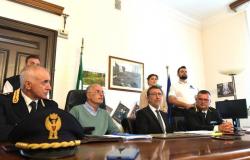On the fiftieth World Environment Day celebrated by the United Nations on 5 June, Istat made available the 2022 update of the historical series of meteorological and temperature statistics for precipitation and temperature for the 109 provincial capitals, where indicators were released of average, maximum, minimum annual temperature and total annual precipitation and Indices of meteorological extremes, calculated with daily data from thermo-pluviometric stations located in the cities.
In 2022, the warmest year recorded since 1971, the average annual temperature of the 109 provincial capitals (calculated as the average of the values detected in the observed meteorological stations) was approximately +16.6°C (with an anomaly of +1 °C compared to the average value of the decade 2006-2015). There are 99 cities affected by an increase in average temperature compared to that decade (above +1°C for 60% of them).
The highest climate differences are recorded for Modena (+3.4°C), Sondrio (+2.6), Cremona (+2.4) and Massa Carrara (+2.1).
For the regional capitals, the average temperature rises to 16.6°C, marking an anomaly of +1.7°C on the 1981-2010 Cline.
Rises in both the minimum and maximum temperatures determine the increase in the average temperature, which presents positive anomalies for all 21 cities: Rome (+2.7°C) and Milan (+2.5) lead the way, followed by Perugia (+ 2.3) and Turin (+2.1).
With the exception of the capitals of the islands of Sicily and Sardinia, in 2022 the ninth highest average temperature of the year was recorded in Foggia with 18.1° (lower only than the 18.3° of 2008 and almost one centigrade higher than to 17.2° in 2006).
Leading the special ranking is Reggio Calabria with 20th; second Taranto with 19.2° and third Massa Carrara with 19.1°. Followed by Latina with 18.9°, Rome with 18.7°, Salerno with 18.4° and Bari 18.2°.
The extreme weather and climate temperature indices show significant increases in 2022 for most of the capitals, where on average there are 136 summer days and 58 tropical nights (respectively +19 days and +20 nights over the decade 2006-2015).
The increase in tropical nights compared to this period affects 96 cities, in particular Oristano (+65 nights), Bologna (+47), Genoa (+45) and Massa Carrara (+44).
Analyzing only the regional capitals, the summer days mark on average an anomaly compared to the 1981-2010 Clino of approximately +28 days, while the tropical nights of +32 nights. In the lead for increases in summer days Rome (+54 days), Genoa and Aosta (+41) and in tropical nights Milan (+57 nights), Turin and Genoa (+49) and Bologna (+47).
In 2022, the total annual precipitation of the 109 provincial capitals, on average equal to 598 mm, marks a decrease of -264 mm on the average value of the decade 2006-2015. Compared to this period, decreases in precipitation were noted for 95 capitals, the highest for Verbania (-922.6 mm), Varese (-869.1), Monza (-824.8), Udine (-681.2) and Turin (-676.6).
Based on the geographical location, the annual precipitation is lower for all the capitals of the Islands and the North-West (equal to approximately 420 mm and 540 mm respectively, values below the 2006-2015 average), areas in where 35.5% of the population of all Italian provincial capitals resides.
For the regional capitals, 2022 was the second least rainy year since 1971, with an average total precipitation of 576 mm (-167 mm on the 1981-2010 Cline). The decline affects 17 cities: led by Milan (-585.5 mm), Genoa (-567.3) and Turin (-496.4). Only Campobasso (+174 mm), Potenza (+98.9), Perugia (+17) and Bari (+2.6) bucked the trend.
In 2022 the total annual rainfall recorded in millimeters in Foggia was 554.7.






